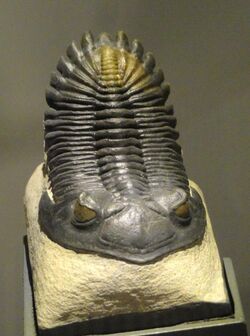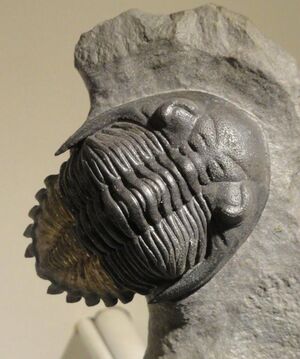Biology:Hollardops
| Hollardops | |
|---|---|

| |
| Hollardops sp. Houston Museum of Natural Science - DSC01602 | |
| Scientific classification | |
| Kingdom: | |
| Phylum: | |
| Class: | |
| Order: | |
| Suborder: | |
| Superfamily: | |
| Family: | |
| Subfamily: | Asteropyginae
|
| Genus: | Hollardops Morzadec, 1997
|
| Species | |
| |
Hollardops is a genus of trilobite in the order Phacopida that lived during the Devonian. Their fossils are found in the upper Emsian of western Europe (France, Spain) and in the lower Emsian to lowermost Eifelian of North Africa (Morocco, Algeria). The type species, Asteropyge mesocristata, was described from Algeria by Le Maître in 1952. The genus Hollardops was erected by Morzadec in 1997.[1] In the same year, Lieberman & Kloc[2] erected Modellops and Philipsmithiana but those genera are regarded as subjective synonyms of Hollardops. The 10-segmented thoracic condition of Hollardops is a rare feature among acastid trilobites that almost always have 11 thorax segments. Van Viersen & Kloc (2022)[3] revisited Hollardops and described a number of new species from the Devonian of Morocco. They also regarded Pennarbedops Bignon & Crônier, 2013 as a synonym of Hollardops. Van Viersen & Kloc construed Hollardops as a scavenger or predator with well-developed eyes, that used its shovel-like cephalon to plough the top layers of the sediment in search of food. Hollardops had small pits horizontally along the fringe of the exoskeleton; these are believed to have housed setae that allowed the trilobite to closely monitor its surroundings.
Description

Houston Museum of Nat. Sci. - DSC01611
Both specimen are from Tazoulait Formation at
Jbel (Jebel) Oufatène [ ⚑ ] 30°50′15″N 4°54′07″W / 30.8374368°N 4.9018067°W[4]
and Issimour [ ⚑ ] 30°58′01″N 5°02′14″W / 30.9669834°N 5.0373266°W[5]
SE of Alnif, western of Oued Alnif, Ma'ider region, Morocco
Hollardops have schizochroal eyes and a glabella that is slightly raised on the surface of the cephalon. Genal spines extend from the cephalon and extend to approximately the 6th thoracic segment.
Hollardops has 10 thoracic segments and also has 5 pairs of pleural lappets or spines projecting from the pygidium.
Length ranges from approximately 3 to 9 cm.
References
- ↑ Morzadec, Pierre (1997-04-29). "Les Trilobites Asteropyginae du Dévonien de l'Ougarta (Algérie)" (in fr). Palaeontographica Abteilung A 244 (4–6): 143–158. doi:10.1127/pala/244/1997/143. Bibcode: 1997PalAA.244..143M. https://www.schweizerbart.de/papers/pala/detail/244/101033/Les_Trilobites_Asteropyginae_du_Devonien_de_l_Ouga?af=crossref.
- ↑ Lieberman, Bruce S.; Kloc, Gerald J. (1997) (in en-US). Evolutionary and biogeographic patterns in the Asteropyginae (Trilobita, Devonian) Delo, 1935. Bulletin of the AMNH ; no. 232. https://digitallibrary.amnh.org/handle/2246/1623.
- ↑ Viersen, Allart P. VAN; J. Kloc, Gerald (2022-12-09). "Functional morphology, coaptation and palaeoecology of Hollardops (Trilobita, Acastidae), with descriptions of new species and two new genera from the Devonian of Morocco" (in en). Geologica Belgica 25 (3–4): 99–144. doi:10.20341/gb.2022.005. ISSN 1374-8505. https://popups.uliege.be/1374-8505/index.php?id=7004.
- ↑ Google Maps: Jebel Oufatene
- ↑ Google Maps: [Jebel] Issimour
Wikidata ☰ Q55639894 entry
 |

